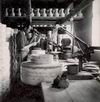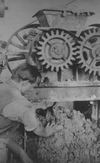|
Brief outline of the production process
The main condition for the production of stoneware goods in Klikov was sufficient supply of quality material. Potters clay, which was extracted in the proximity of the village, lies few meters under the surface. It was mainly extracted by local farmers on their own land and then sold to the potters.
The clay was first let to freeze before further processing. The most traditional method was stamping on the clay with bare feet and cutting thin slices from a large piece of pounded clay. This process was repeated few times. Later the potters used two rollers, which turned; the clay was put between them – so called “claycutter”. Most sophisticated was a method where rough particles of the clay settled at the bottom of a tank and the fine part ran into other tanks, where it slowly dried in the sunshine. The finished clay was than wedged and let to rest.
By mixing different clays the potters achieved optimal quality ceramic clay. Certain clay was used for vessels, which were not meant to be porous. Other clays were used for pots for cooking on a stove, they had to withstand rapid rise in temperature without cracking. Yet another kind of clay was used for flowerpots and garden ceramics.
The articles were made on kick wheels. Only later, at the beginning of the 20th Century, turning apparatus called “mašinka” was introduced. Other products, such as shapes for baking Easter lambs were made with plaster moulds.
Brown ware was glazed with a special slip, which replaces glaze - “šlemovka”; the white ware was often decorated with a technique of underglaze painting. When the pots were dried well, they were loaded into the wood kiln (“Kassels kiln”) to be fired.
The workshop usually had three throwers, one person who did glazing and one who chopped wood. The master of the workshop usually knew all the specialised techniques and he looked after the smooth working of the workshop.
|




click to enlarge
|
|




